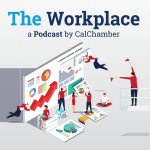 There are so many different types of workers: hourly employees, managers, supervisors, exempt employees, and independent contractors. But how do you classify each one under California labor laws?
There are so many different types of workers: hourly employees, managers, supervisors, exempt employees, and independent contractors. But how do you classify each one under California labor laws?
In this week’s episode of The Workplace, CalChamber Executive Vice President and General Counsel Erika Frank discusses exempt employee misclassification with employment law expert Jennifer Shaw. In the podcast, they discuss the differences between exempt and non-exempt employees and the common mistakes employers make when classifying their employees as exempt.
Exempt vs. Non-Exempt
One of the most common mistakes employers make is misclassifying an hourly worker as an exempt employee. “To be exempt in California, you have to meet two tests: a salary test and a duties test,” says Shaw.
According to California labor laws, salary means the employee’s pay is “not subject to variation based on the quality or quantity of work,” Shaw tells Frank.
When employees are exempt, the employer does not pay overtime, but the exempt employee has more independence than an hourly employee. “Many employees want to be exempt because they don’t have to clock in and out, they can take a longer lunch, they can come and go as they please, and they are still getting the same amount of pay,” adds Frank.
“It is very important for employers to know that the law presumes employees to actually be non-exempt,” Shaw says. “So it is always an employer’s burden to show that an employee is exempt. Exempt means exempt from all of those wage-and-hour laws that we freak out about: rest breaks, meal periods, overtime, on call, reporting time pay, callback pay. All of that does not apply when you have an exempt employee.”
Many employers are making all employees non-exempt, including assistant managers and other high-level positions that make enough to meet the salary basis test. Employers are opting toward making employees with “high-level discretionary duties that are required for that exempt status” non-exempt because it eliminates the risks.
Among the categories of exempt employees are the white collar exemptions, which include the professional exemption, administrative exemption and executive exemption. To be classified as an executive exempt employee, the employee must supervise two or more full-time employees. “Supervise means hiring, firing, performance management, workflow, giving performance evaluations,” says Shaw. For each of these exemptions, employees must spend more than 50 percent of their time doing those tasks.
Administrative exempt employees may run a department or quality control or manage facilities. Professional exempt employees may “be licensed, like an attorney, architect, or a dentist,” Shaw says. “They might be a computer professional or a creative professional, like a reporter or an artist.”
To make matters more complex, classification is done on a workweek by workweek basis. “So you can have someone who is exempt one week and non-exempt the next week,” Shaw says. “This is all driven by federal law.”
When Employees Are Unsatisfied
When it comes to classifying employees, Shaw explains, employers may face difficulty convincing their employees of the benefits of being non-exempt if they are not careful. Misclassification lawsuits are very common and even satisfied employees may be tempted by the financial bonus, Shaw warns. “The whole thing comes into play when somebody’s upset or they notice their pay isn’t the way it should be or when they feel like they are being monitored.”
It is important for employers to understand how easily this issue can lead to legal implications. “What employers need to know is it is not difficult for a lawyer to say you have misclassified or you haven’t given rest breaks or meal periods and it is too expensive to defend,” Shaw tells Frank. In addition, “There is no evidence an employer can use or have to rebut the employee’s assertion,” Frank adds.
Communication is key when it comes to making changes to employees’ classification. Shaw suggests reverse engineering to make sure employees know they will not be taking a pay cut. It is also crucial to discuss the positives of being non-exempt, such as overtime pay, rest and meal periods, with employees when changing their classification.
Webinar
CalChamber is presenting a live webinar, Classifying Exempt Employees in California, on Thursday, June 20, 2019, 10 a.m. to 11:30 a.m. (Pacific).
Subscribe to The Workplace
Subscribe to The Workplace on iTunes, Google Play, Stitcher, PodBean and Tune In. New episodes will be released each Wednesday.
To listen or subscribe, visit www.calchamber.com/theworkplace.

